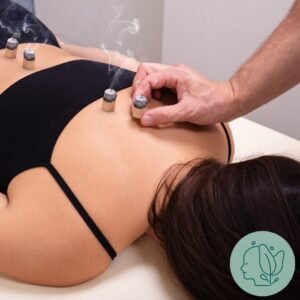Moxa therapy: heat as a healing force
Traditional Chinese medicine is all about the balance of energy, also known as qi. When this flow of energy becomes disrupted, symptoms can arise. Besides acupuncture, moxa therapy is used to restore balance. It is an ancient method that uses heat to support the body.

What is moxa therapy?
Moxa therapy uses mugwort (Artemisia), an herb known worldwide from cooking, but with therapeutic uses in Chinese medicine. The leaves are dried and processed into small cones or sticks that, once lit, heat specific points on the body.
The twelve meridians
According to traditional teachings, moxa stimulates the 12 meridians in which qi and blood flow. The heat dissipates cold, strengthens yang energy and supports the body's self-healing ability. Especially when there is a lack of yang. This can manifest itself in coldness, fatigue and weakened resistance, then moxa is a valuable addition.
What does a treatment look like?
There are two forms of moxa therapy:
- At direct moxa the therapist places a burning moxa cone directly on the skin. This requires extreme precision to avoid burning.
- Indirect moxa, the most commonly used form in the Netherlands, holds the burning moxa just above the skin, often in combination with acupuncture needles or a tool such as ginger or a moxa box.
Correct application gives a pleasant, deeply penetrating sensation of warmth, without pain or blisters.
When is moxa therapy used?
Moxa therapy is often recommended for complaints related to cold or lack of energy, such as:
- Joint pain
- Digestive problems
- Menstrual complaints
- Reduced fertility
- Sagging of organs
One particularly well-known use is in breech presentation during pregnancy. Research published in the journal Complementary Therapies in Medicine shows that moxa increases the chances of a baby turning spontaneously, especially when treatment starts around week 34.
Suitable for everyone?
Moxa is generally safe if performed by a properly trained therapist. With direct moxa, there is a risk of burns. People with allergies to mugwort, asthma or sensitivity to smoke should avoid moxa. When pregnant, consultation with the practitioner is important.
Case study
Marieke, 22, had been suffering from cold hands, fatigue and digestive complaints for months. After a few sessions of moxa therapy, she felt more energetic and her symptoms noticeably decreased. "The heat felt like a deep relaxation, and I noticed more balance in my body after each treatment," she says.
Curious about moxa therapy and whether it is for you? Find recognised therapists near you via the overview on therapievergelijk.nl.